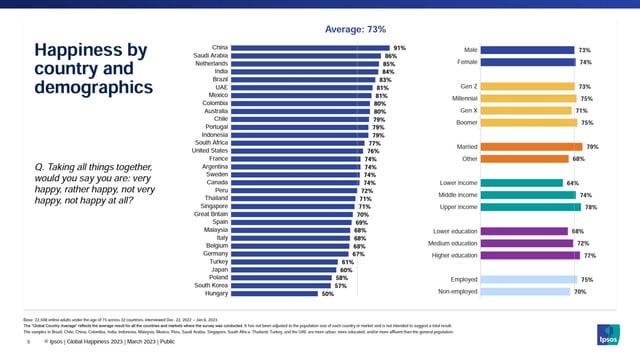this post was submitted on 27 Nov 2023
-1 points (48.8% liked)
World News
32327 readers
893 users here now
News from around the world!
Rules:
-
Please only post links to actual news sources, no tabloid sites, etc
-
No NSFW content
-
No hate speech, bigotry, propaganda, etc
founded 5 years ago
MODERATORS
you are viewing a single comment's thread
view the rest of the comments
view the rest of the comments

It's pointless survey.
It's usually an annotation because Internet/phone penetration among the rural, uneducated, and poor in those countries isn't great. They don't have means to survey these people. Surveying the people who do have access to Internet is representative of what "normal people" feel.
The US has ~91% Internet penetration, while China only has 73% and India only 43%.
That's a factor sure, but someone living in rural country and urban city will have different happiness index based on their living conditions and satisfaction drivers. So comparing X with Y = flawed results.
Isn't happiness the goal? Why does it matter what their driver is?
Tell me you didn't read the report without saying you didn't read the report. Satisfaction drivers are the metrics for the happiness in that report.
Then your statement doesn't make sense lol
The rural/urban divide isn't unique to China or India or Brazil. It's everywhere. Drivers are always different across the urban/rural divide.
That is the point. When you exclude that group of people only from 15 out of 32 surveyed countries, you skew the results for the whole survey. You can't draw parallel conclusions from different samples.
The goal of this comparison is to compare urban-to-urban, because those countries which don't have this exclusion have relatively tiny rural populations.
Then it ISNT a
"Global Happiness Index"
, rather it is a
"Global URBAN Happiness Index",
and such profound mislabeling of things is disinformation, not journalism.
Which, itself, is so systematic & profound, nowadays, that there isn't much hope for integrity to win, in our world, now, anyways.
That is the conclusion you have drawn, but it's not part of the methodology listed in the survey. They haven't excluded rural participants from the 17 countries, while explicitly excluding them from 15 countries. If you see no issue with that, enjoy your blinders, but please stop spreading misinformation.
Rural populations are negligible and covered under other factors in a number of countries (in the US, Internet access). It's not worth mentioning because it's not a relevant part of data.
"This survey doesn't fit my worldview so it's pointless."
I bet you verify the fine print on surveys that do fit your worldview too, huh
Yes, I check the data makeup of every survey I view. The sample data that is not using the same criteria for every participant skews the results. If I ask 10 politicians if they think they are doing a good job I get one set of results, but if I ask 10 McDonald employees if their elected politicians are doing great job, results will be different. If you can see the difference there, then the problem is you, not me.